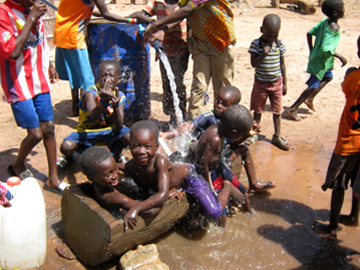The Gambia (West Africa) Drinking Water Project
Roddy Rogers' Mission Trip
Read about Roddy Rogers' mission trip in Gambia-West Africa, in his own words.
Read about Roddy Rogers' mission trip in Gambia-West Africa, in his own words.
My church had been in the village for serving and the need for water was expressed by village leaders on several visits—and was evident. My church leaders knew of my involvement with third world water projects and asked if I could help. I thought a portable system like I had installed in Haiti after the 2008 earthquake might be applicable. So, I went there twice to determine through engineering investigations and tests to see if it would be feasible.
Gambia is a little sliver of a country surrounded by Senegal on the West Coast of Africa at the western most point of the continent. This country is the country of “Roots” fame.
An assessment report has been developed which includes a community survey, water sanitation and Hygiene Status, organizational capacity, ability for equity and contribution, testimonial need for water, seasonal patterns, electricity capability, and an index of water sources. Info on each water source from location to yield to quality has been analyzed. The system would consist of appropriate treatment, storage, and distribution. (pump, solar panels, piping, chlorinator, and filtering if necessary).
Water Missions International has developed a very successful “portable” treatment system and has also sent a person who specializes in community development to assess community buy in and capability of supporting a water system. This included current business practices, stability, leadership potential and willingness to take ownership. The community demonstrated a readiness and willingness. The village, Mbullum, is a community of grass and mud huts and some block buildings housing 1600 people. It is 97% Muslim. There primary mode of income is peanut farming—all by hand—including shelling.
Initial investigations from the first trip conducted numerous water quality tests and concluded that the water from the village's hand dug wells requires treatment. Improving the water quality will decrease water related illnesses.
The second trip included pump tests (excitement during pump test show above) that showed the quality-based selected well will yield adequate water for the village. The second trip also included surveys to layout two “legs” of piping will result in less time spent carrying water, freeing up more time for moms to be moms or even work for much needed income. It also included the community assessment described above.
“We are pursuing multiple avenues and organizations to raise funds to establish a potable, accessible drinking water system in a third world village. MO AWWA participation would allow our section to be directly involved in a project to secure the future of a community in need through securing water.”
— Roddy Rogers, P.E., D.WRE, F.ASCE
Manager − Water Resource Projects
Director − MO Section AWWA
“MO Section AWWA contributes to various philanthropic causes from Water for People to High School Student Scholarships to College and University organizations. All that definitely affect individuals as well as communities but this is the first time one of our own active member approached the section with a specific water missional project that the section could get first hand feed-back on its contribution.”
— Drew Hess
Past Chair − MO Section AWWA
